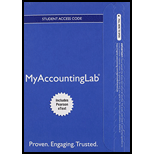
Concept Introduction
Debt Ratio: Debt ratio is a financial ratio that shows the percentage of total assets that is financed by the total liabilities of a company.
Earnings per Share: Earnings per Share (EPS) is a financial profitability ratio that measures the amount of net income available to common stockholders earned on one share. It is calculated by dividing net income available to common stockholders by the average (or weighted average) number of shares outstanding during a period.
Requirement 1
To Compute:
Yankee Traveler’s current ratio, debt ratio, and earnings per share.
Requirement 2
To Compute:
The three ratios that are current ratio, debt ratio and earnings per share after evaluating the effect of each given transaction.
Want to see the full answer?
Check out a sample textbook solution
Chapter 17 Solutions
MyLab Accounting with Pearson eText -- Access Card -- for Horngren's Accounting, The Financial Chapters (My Accounting Lab)
- Kate Corporation owns a patent on an automated system. The company has been amortizing the patent on a straight-line basis since 2013, when it was acquired at a cost of $60 million at the beginning of that year. Due to technological advancements, management has now decided that the patent will benefit the company for a total of five years instead of the original ten-year amortization period. This decision was made at the end of 2016 (before adjusting and closing entries). What is the appropriate 2016 amortization expense for the patent?arrow_forwardCalculate the Operating Cash Flow (OCF) from the following data: • Change in net fixed assets: $25,000 • Change in net working capital: $30,000 • Dividends Paid: $35,000 Depreciation Expense: $40,000 • Interest Paid: $22,000 • Net New Borrowing: $18,000 • Net New Equity Issued: $12,000arrow_forwardA machine costing $92,500 with a 9-year life and $88,200 depreciable cost was purchased on January 1. Compute the yearly depreciation expense using straight-line depreciation. Round the answer to the nearest whole dollar.arrow_forward
- What are the beginning and ending amounts of equity on these financial accounting question?arrow_forwardGeneral accounting questionarrow_forwardSeveral years ago, a parent company acquired all of the outstanding common stock of its subsidiary for a purchase price of $320,000. On the acquisition date, this purchase price was $75,000 more than the subsidiary's book value of Stockholders' Equity. The AAP was entirely attributable to Goodwill. On the date of acquisition, the parent company's management believed that the goodwill had a 10-year useful life. Since the date of acquisition, the subsidiary has reported a cumulative net income of $260,000 and paid $105,000 in dividends to its parent company. Compute the balance of the Equity Investment account on the parent's balance sheet, assuming that the Goodwill asset has not declined in value since the date of acquisition.arrow_forward

 AccountingAccountingISBN:9781337272094Author:WARREN, Carl S., Reeve, James M., Duchac, Jonathan E.Publisher:Cengage Learning,
AccountingAccountingISBN:9781337272094Author:WARREN, Carl S., Reeve, James M., Duchac, Jonathan E.Publisher:Cengage Learning, Accounting Information SystemsAccountingISBN:9781337619202Author:Hall, James A.Publisher:Cengage Learning,
Accounting Information SystemsAccountingISBN:9781337619202Author:Hall, James A.Publisher:Cengage Learning, Horngren's Cost Accounting: A Managerial Emphasis...AccountingISBN:9780134475585Author:Srikant M. Datar, Madhav V. RajanPublisher:PEARSON
Horngren's Cost Accounting: A Managerial Emphasis...AccountingISBN:9780134475585Author:Srikant M. Datar, Madhav V. RajanPublisher:PEARSON Intermediate AccountingAccountingISBN:9781259722660Author:J. David Spiceland, Mark W. Nelson, Wayne M ThomasPublisher:McGraw-Hill Education
Intermediate AccountingAccountingISBN:9781259722660Author:J. David Spiceland, Mark W. Nelson, Wayne M ThomasPublisher:McGraw-Hill Education Financial and Managerial AccountingAccountingISBN:9781259726705Author:John J Wild, Ken W. Shaw, Barbara Chiappetta Fundamental Accounting PrinciplesPublisher:McGraw-Hill Education
Financial and Managerial AccountingAccountingISBN:9781259726705Author:John J Wild, Ken W. Shaw, Barbara Chiappetta Fundamental Accounting PrinciplesPublisher:McGraw-Hill Education





